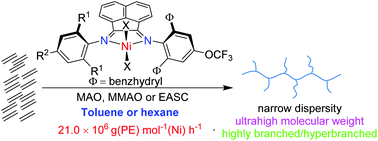Trifluoromethoxy-substituted nickel catalysts for producing highly branched polyethylenes: impact of solvent, activator and N,N′-ligand on polymer properties†
Abstract
The para-trifluoromethoxy-substituted 1,2-bis(imino)acenaphthenes, 1-[2,6-{(C6H5)2CH}2-4-F3COC6H2N]-2-(ArN)C2C10H6 (Ar = 2,6-Me2C6H3L1, 2,6-Et2C6H3L2, 2,6-iPr2C6H3L3, 2,4,6-Me3C6H2L4, 2,6-Et2-4-MeC6H2L5), have been synthesized and utilized to generate their respective nickel(II) halide complexes, LNiBr2 (Ni1–Ni5) and LNiCl2 (Ni6–Ni10). Characterization of the complexes has been achieved via elemental analysis, 19F NMR, 1H NMR and FT-IR spectroscopy. In addition, representative molecular structures have been determined with bromide-containing Ni1, Ni3 and Ni4 adopting discrete mononuclear species while Ni9 assumes a chloride-bridged dinuclear arrangement. The polymerization of ethylene promoted by Ni1–Ni10 in combination with either MAO (methylaluminoxane), MMAO (modified methylaluminoxane) or EASC (Et3Al2Cl3) as activator, furnished highly branched polyethylenes; evidence for hyperbranched materials is also presented. As a notable observation, higher activity was seen in hexane than in toluene with levels reaching up to 21.0 × 106 g of polyethylene (PE) (mol of Ni)−1 h−1 at 30 °C for Ni5/MAO. The resulting polyethylenes exhibited very high molecular weights (up to 16.0 × 105 g mol−1 for Ni8/MMAO) with branching densities reaching up to 186 branches per 1000 carbon atoms. Moreover, the run temperature, solvent and the type of aluminum activator employed have been shown to strongly influence the branching density and type of branch. Furthermore, good mechanical properties (εb up to 984%) and elastic recovery (up to 71%) were a feature of these polymeric materials, properties that are distinctive of thermoplastic elastomers (TPEs).

- This article is part of the themed collection: Polymer Chemistry Recent HOT Articles


 Please wait while we load your content...
Please wait while we load your content...